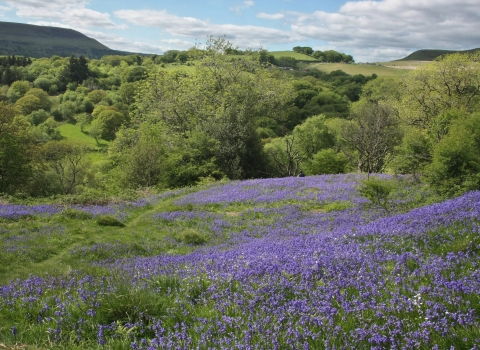
Central Valley wildflowers by Jane Corey
Central Valley
Know before you go
Dogs
Please ensure you clean up any dog mess
When to visit
Amseroedd agor
Open at all timesAmser gorau i ymweld
Spring and summerAm dan y warchodfa
Standing in the middle of this site, it’s hard to believe that this was once the largest steelworks in Europe. A haven for wildlife and owned by Blaenau Gwent County Borough Council (BGCBC), Central Valley has now been returned to BGCBC management, by Gwent Wildlife Trust, who managed the site between 2015 and 2023.
As the reserve erupts with wildflowers and grasses in the spring and summer, it becomes a paradise for butterflies and bees. Over 10 species of butterflies have been recorded here, including graylings and dark green fritillaries. Small mammals live in the undergrowth, providing food for the barn owls and kestrels seen hunting on the reserve from time to time. Drawn to the warmth of the scrubby slopes and the abundance of insects to feed on, reptiles like slow worms and common lizards have made their home here. The trees and scrub areas around the edge of the reserve are full of birds and attract visiting spring migrants like chiffchaffs and willow warblers. The new wetland habitat is already full with the jewel-like colours of darting dragonflies, damselflies and kingfishers.
What we do here
This site has undergone extensive landscaping, tree planting and seeding and now supports a variety of grasslands, young woodland, ponds and reedbeds, creating a fantastic urban oasis for both people and wildlife.
Adjacent to the reserve is our Environmental Resource Centre, where we run courses, training and events. From here, you can hire one of our Explorer Rucksacks that contains all you need to spot the birds, bees, butterflies, dragonflies and pond life that lives on the reserve.
In 2015, Gwent Wildlife Trust’s Furnace to Flowers project won the public vote to become the Grow Wild Wales flagship project. We plan to transform a 20 hectare corridor running through The Works as far as Festival Park by planting native wildflowers, demonstrating the potential of post-industrial areas to provide homes for many species of wildlife as well as beautiful, peaceful places for people to enjoy.
History
Founded in the late 1700s with a single blast furnace producing pig iron, the site continued to grow through the years before adopting the revolutionary Bessemer process of converting iron to steel in the 1850s. Expansion of the steel manufacture progressed into the 20th Century until an economic depression in the early 1930s closed the site. Changing hands in 1935, the site was redeveloped and re-established as a forerunner in the industry. It was nationalised in the 1950s and after a slow decline from the 1980s onwards, it finally shut up shop in December 2002. Much of the site was demolished but its heritage lives on in the nearby Steelworks General Offices, now home to The Works Museum and archival unit.
The Environmental Resource Centre was built in 2010 and sits alongside the old redbrick pump house and former cooling ponds.
Directions
By car
From Ebbw Vale, head south on the A4046 (Park Road) for approximately 2km. At the first roundabout take the 2nd exit (signposted ‘Aberbeeg – A40466/Newport’) and at the next roundabout take the 1st exit (signposted ‘Abergavenny/Merthyr Tydfil/The Works). At the next roundabout, take the 2nd exit on to Strand Annealing Lane and follow this road for approximately 600m. Pass the school on your left and immediately after the footbridge take the turning on your left into the Environmental Resources Centre car park.
Travelling north from Newport, follow signs for ‘Festival Park’, continuing towards Ebbw Vale via the A4046. After passing through the villages of Cwm and Waun-Lwyd, take the 2nd exit at the roundabout (signposted ‘Abergavenny/Merthyr Tydfil/The Works’) and continue with the directions as above.
Near the reserve
Gwent Wildlife Trust’s magnificent Silent Valley nature reserve is a short drive away.
In the local area, you can visit the Ebbw Vale Works Museum to learn more about the coal, iron and steel industry and the history of the site where Central Valley and the Environmental Resource Centre now stand.

